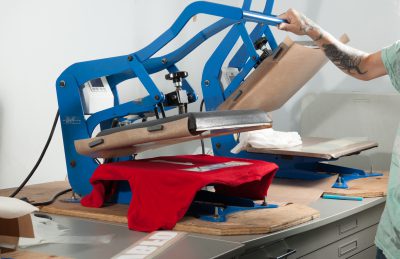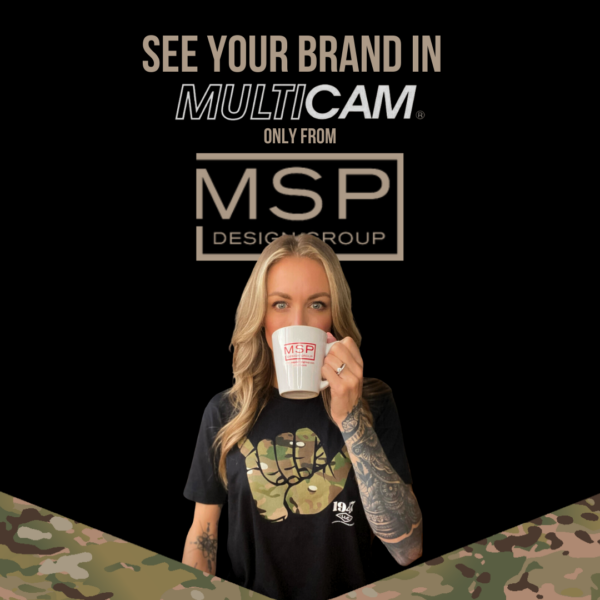
Screen Printing Equipment
The screen printing process involves a variety of tools and equipment necessary to produce high quality, durable garments. We’re examining screen printing equipment, offering explanations on each piece to clear away the fogginess surrounding this traditional method.
Preparation
Screens are one of the primary tools of screen printing. These are framed mesh sheets that will bear the design when printing. The mesh is typically made from polyester, and different mesh counts can be used to produce varied printed ink appearances. The typical count for mesh is 110, but it is up to the printer on what they wish the ink to look like. Screens are coated in another essential element of screen printing called emulsion. This liquid is a light-sensitive chemical that, when exposed to light, “burns” a design into the mesh. These exposure units are what screens are placed in, and when turned out a vacuum is created inside. When light hits emulsion, the liquid surrounding the design hardens. The liquid beneath the black ink of the design, which has already been digitally printed in black ink on a film positive, however, does not cure. This allows the printer to wash out that area, resulting in the shape of the desired stencil. Multiple screens are often needed to give the design the dimension it needs.
Rotary Press
Once screens are prepped, they are moved to the most important piece of screen printing equipment: the rotary press. There are many types and configurations of the rotary press, but all work in a similar fashion. Plus, the adjustable nature of the press allows for unique items to be printed, like glassware, canvas bags, hats, and more. Screens are placed and registered into one of several pallets. A garment is fitted on the print head, which carousels around to each screen. A printer will usually load several garments onto the press’s print heads, multitasking the process. Ink is spread up and down the screen, which is called flooding and stroking, with a squeegee. The ink most commonly used in screen printing is called Plastisol, which is made of PVC particles. The squeegee pushes the ink through the mesh of the screen where the emulsion was not cured.
Final Touches
Once the ink has been printed onto the garment, it can be immediately rotated under a flash dryer. This dryer heats the ink in order to dry it enough for the next step of ink. Garments are frequently placed in belt dryers when the last screen of ink has been placed on. By the end of the rotation, the item will be fully printed and dried. Printers can complete many items at a time, and here at MSP, we can complete 2,000 shirts an hour!
At MSP, we love giving guided tours through our facility, teaching people about our process. Our production facilities house automatic presses, manual presses, and digital printing machines, allowing us to produce over 1 million shirts per year. For over 30 years we’ve been screen printing, and what better way to show our love for it than to teach others about it! We frequently host schools and other groups, demonstrating how screen printing works and even letting them try their hand at creating their own t-shirt! For more information about setting up an appointment to come say hello to our screen printing machines, please contact us.
Increase Your Results with Branded Merchandise Solutions

Elevate Your Brand with Custom Merchandise
Our personalized service, global sourcing, local production, and in-house creative team make finding the perfect promotional products a breeze.
Discover the Perfect Promotional Products for Your Brand! Click Here to Get Started.

Design Custom Apparel that People Love to Wear
Our 100,000 sq ft state-of-the-art facility handles a wide range of apparel and decoration methods. Let’s create something on-trend and truly unique for your brand.
Create Trendy, Custom Apparel for Your Brand!

Make A Lasting Impression with Impactful Visual Communications
From signage and wayfinding to environmental graphics, our expert team can create custom solutions that elevate your brand and guide your audience.
Elevate Your Brand with Custom Visual Communications! Click Here to Learn More.
 Online Solutions to Elevate Your Brand
Online Solutions to Elevate Your Brand
Our ecommerce solutions are perfect for gifting, rewards and recognition programs, team gear, fundraising, or selling your products directly to customers. Our advanced platforms offer seamless shopping experiences, fun gifting options, and secure transactions.
Boost Your Brand with Our Ecommerce Solutions! Click Here to Explore.
 We Do the Heavy Lifting So You Don’t Have To
We Do the Heavy Lifting So You Don’t Have To
MSP Design Group provides an in-house, NetSuite enabled kitting, warehouse and fulfillment facility. We provide end-to-end solutions tailored to your unique needs. With complete control of our processes, your program is in excellent hands.
Streamline Your Operations with Our End-to-End Solutions!
 Our In-House Creative Team Has You Covered
Our In-House Creative Team Has You Covered
Looking to create your own unique apparel designs? Envision a unique product that doesn’t exist yet? Want to create a new experience? MSP Design Group’s team of in-house creatives, designers, merchandisers and program experts are ready to help bring your vision to life.
Bring Your Vision to Life with Our In-House Creative Team! Click Here to Learn More.






